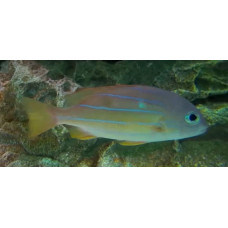Latin name
Lutjanus quinquelineatus
Other name
Blue-striped snapper, blue-banded sea-perch, five-lined seaperch, gold-striped sea-perch.
Identification
This fish has a moderately deep body, with a standard length of 2.3-2.9 times its depth. It has a steeply sloped forehead and a distinct, well-developed antebrachial incision and ridge. The front teeth are arranged in a crescent shape, and there are no teeth on the smooth tongue. The dorsal scale rows are obliquely elevated above the lateral line.
Features of fish fins
The dorsal fin contains 10 spines and 13-15 soft rays, while the anal fin has 3 spines and 8-9 soft rays. The dorsal and anal fins have a rounded to slightly angular posterior profile. The pectoral fins contain 16 or 17 rays, and the caudal fin is either truncated or weakly pointed.
Fish colouring
The top of the head is brownish, but the overall coloration of this fish is yellow with five bright blue horizontal stripes on the sides. There is usually a black spot on the upper back of the body.
Distribution
Widespread in the Indo-Pacific region. They occur in the Persian Gulf, Gulf of Oman, Sri Lanka, and southern India in the Indian Ocean, and from the Andaman Sea eastward to Fiji, Tonga-Tahiti, and the Caroline Islands in the Pacific Ocean, northward to Japan, and southward to Australia. In Australian waters, the species is distributed from the central coast of Western Australia along the tropical north coast and south along the east coast to central New South Wales.
Habitat
Found in sheltered lagoons and open water, on the outer slopes of coral reefs at depths of 2 to 40 m (6 feet 7 inches and 131 feet 3 inches). Juveniles occur in sheltered bays with a base of rubble and algae.
Size
The maximum total length of this species is 15 inches (38 cm), although 12 inches (30 cm) is more typical. Maximum reported age: 31 years.
Behavior
Five-lined snappers form large schools in some areas of the Pacific Ocean and are usually found in large aggregations at depths of 30 to 40 m (98 to 131 feet) that may exceed 100 individuals. Juveniles are solitary.
Food and feeding habits
It is a predatory species whose diet is dominated by fish and crustaceans.
Reproduction
Off the coast of New Caledonia, spawning lasts most of the year, peaking from November to January.
Fishing
Important for artisanal fisheries in some parts of their range. They are caught using lines, traps and gill nets. They are a valuable quarry for recreational anglers in Queensland.
Relationship with a person
It is considered a high quality food fish and is also used in the aquarium trade.
| Classification | |
| Phylum | Chordata |
| Class | Actinopterygii |
| Squad | Perciformes |
| Family | Lutjanidae |
| Genus | Lutjanus |
| Species | L. quinquelineatus |
| Features | |
| Conservation status | Least Concern |
| Habitat | Pelagic |
| Life span, years | 31 |
| Maximum body weight, kg | No information |
| Maximum length, cm | 38 |
| Sailing speed, m/s | No information |
| Threat to people | Edible |
| Way of eating | Predator |
Five-lined snapper
Tags: five lined snapper



